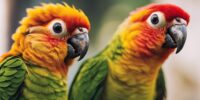How to Recognize the Vocal Patterns Unique to Specific Parrot Species

Recognizing vocal patterns in parrot species is a fascinating field of study that involves understanding the unique calls of each species. Parrots are known for their impressive vocal abilities, which vary significantly between different species. By analyzing these vocal patterns, researchers can gain insights into the behavior, communication, and social dynamics of parrot populations. Understanding the distinct calls of each species is essential for conservation efforts and for improving our overall knowledge of these intelligent birds.
Parrot vocalizations can serve various purposes, including mate attraction, territorial defense, and maintaining group cohesion. By studying these vocal patterns, scientists can better understand the complex social structures within parrot communities. This research can also help identify individual birds, track population dynamics, and monitor the health of wild parrot populations. With advancements in technology and research methods, our understanding of parrot vocalizations continues to deepen, providing valuable information for conservationists, behaviorists, and bird enthusiasts alike.
Understanding Parrot Vocalizations
When studying parrot vocalizations, researchers closely observe the various sounds and patterns emitted by different species to decipher their communication methods and social behaviors. Parrot speech patterns exhibit a diverse range of unique vocalizations that are crucial for their interactions within flocks and with other species. These vocalizations can vary from simple squawks and chirps to complex mimicry of human speech and environmental sounds.
Each species of parrot has its own set of vocal patterns that are used for specific purposes such as mating rituals, territorial defense, or warning calls. For instance, African Grey Parrots are known for their exceptional ability to mimic human speech with remarkable clarity, while Sun Conures produce loud, high-pitched calls to communicate over long distances in their native habitats.
Understanding these unique vocalizations is essential for researchers and enthusiasts alike to gain insights into the intricate communication systems of parrot species and their fascinating social dynamics. By studying and decoding parrot speech patterns, we can appreciate the complexity and intelligence behind these remarkable birds' vocal behaviors.
Identifying Vocal Patterns in Macaws

Parrot vocalizations have long intrigued researchers, and now the focus shifts specifically to the distinctive vocal patterns exhibited by Macaws. Macaw vocalizations are complex and varied, reflecting the diverse behaviors and emotions of these magnificent birds. When identifying macaw calls, behavior analysis plays a crucial role in understanding their vocal repertoire.
- Macaw Species Variation: Different macaw species exhibit unique vocal patterns, allowing for species identification based on calls.
- Contextual Analysis: Macaws often vocalize in response to specific stimuli or situations, indicating their emotional state or intentions.
- Vocal Mimicry: Some macaws, like the Blue and Gold Macaw, are known for their ability to mimic human speech and other sounds in their environment.
- Diurnal vs. Nocturnal Vocalizations: Macaws exhibit different vocal behaviors during the day and night, which may vary based on species.
- Repetitive Calls: Macaws often use repetitive calls for communication, with each repetition serving a specific purpose in their social interactions.
Deciphering Cockatoo Vocalizations

Cockatoos exhibit a wide range of vocalizations, including screeching behaviors that serve various communication purposes within their social groups.
Their mimicry abilities are highly developed, allowing them to imitate a diverse array of sounds from their environment with remarkable accuracy.
Understanding the nuances of cockatoo vocalizations can provide valuable insights into their social dynamics and cognitive capacities.
Cockatoo Screeching Behavior
Among the cacophony of sounds emitted by these charismatic avian creatures, deciphering the vocalizations of cockatoos presents a unique challenge to researchers and enthusiasts alike. Cockatoo communication involves various screeching patterns that convey different messages and emotions. Understanding these vocalizations is crucial for interpreting the bird's state of mind and responding appropriately.
Managing cockatoo screeching requires patience and a deep understanding of their behavior. Behavior modification techniques can be employed to reduce excessive screeching and encourage more desirable vocalizations. Observing the context in which the screeching occurs, such as during playtime or when seeking attention, can provide insights into the reasons behind the behavior.
- Analyzing pitch and frequency variations
- Identifying distress versus excitement calls
- Recognizing alarm signals
- Differentiating between territorial screeches and mating calls
- Implementing positive reinforcement techniques
Cockatoo Mimicry Abilities
Deciphering the vocal mimicry abilities of cockatoos reveals a complex interplay of learned sounds and environmental influences. Cockatoos employ various mimicry techniques to acquire and reproduce sounds from their surroundings. Through vocal learning, these birds expand their vocal repertoire, showcasing impressive communication skills within their social groups.
Studies have shown that cockatoos can mimic not only the sounds of other birds but also human noises and even music, displaying a remarkable capacity for vocal imitation. Environmental factors, such as the presence of other vocal individuals or the need to attract mates, can influence the development and diversity of their vocalizations. Understanding these mimicry abilities provides insight into the cognitive abilities and social dynamics of these intelligent avian creatures.
Recognizing African Grey Parrot Calls

Researchers have successfully identified distinct vocal patterns in African Grey Parrot calls, shedding light on the species' communication abilities. African Grey Parrots are known for their impressive mimicry skills and complex vocalizations. Here are some key points to recognize African Grey Parrot calls:
- Variability: African Grey Parrot vocalizations exhibit a wide range of tones and pitches.
- Contextual Understanding: Different calls are used in various situations, such as feeding, mating, or warning of danger.
- Emotional Expression: These parrots can convey emotions like happiness, fear, or loneliness through their calls.
- Learning Capacity: African Greys have the ability to mimic human speech and environmental sounds with remarkable accuracy.
- Individuality: Each African Grey Parrot has a unique vocal signature, allowing for identification within a group.
Understanding the nuances of African Grey Parrot calls through grey parrot squawk analysis and African parrot vocalizations interpretation can provide valuable insights into their behavior and social interactions.
Distinguishing Amazon Parrot Sounds

Distinguishing Amazon Parrot sounds requires keen auditory discernment due to the species' diverse vocal repertoire and distinctive cadences. Amazon parrot chatter is characterized by a mix of squawks, whistles, and mimicry abilities that vary among the different Amazon species. To understand these vocalizations better, it's essential to delve into the parrot vocalizations anatomy. Amazon parrots possess unique structures within their vocal apparatus, such as the syrinx, a specialized vocal organ found in birds, enabling them to produce a wide range of sounds. Their vocal cords are capable of modulating airflow, allowing for the production of both high-pitched and low-pitched tones.
Observing an Amazon parrot closely can reveal subtle nuances in their vocalizations, from soft murmurs to loud calls. Their cadences may also vary depending on their mood or environment. By paying attention to these vocal cues and the distinct features of Amazon parrot sounds, enthusiasts can gain a deeper appreciation for these intelligent birds.
Interpreting Eclectus Parrot Vocalizations

The intricate vocalizations of Eclectus parrots showcase a unique blend of melodic tones and distinct calls, setting them apart within the avian vocal landscape. These vocalizations play a crucial role in Eclectus parrot communication, allowing them to convey various messages and emotions to their flock members. Interpreting eclectus parrot calls involves a deep understanding of their behavior and the context in which the sounds are produced.
- Distinct Calls: Eclectus parrots have a wide range of distinct calls that serve different purposes within their social structure.
- Pitch Variations: The pitch variations in Eclectus parrot vocalizations can indicate their mood or the urgency of a situation.
- Response to External Stimuli: Observing how Eclectus parrots react vocally to external stimuli can provide insights into their perception and awareness.
- Call Sequences: The sequences in which Eclectus parrots produce calls can reveal hierarchical dynamics and social interactions.
- Temporal Patterns: Analyzing the temporal patterns of Eclectus parrot vocalizations can help in deciphering their daily routines and activities.
Differentiating Conure Vocal Patterns

Differentiating Conure vocal patterns reveals a diverse repertoire of sounds that play a significant role in their social interactions and communication within their flock. Conure chirping behavior is a prominent feature that varies among different species and individuals. Green-cheeked conures, for example, are known for their high-pitched and rapid chirps, often used during play or to express excitement. In contrast, Sun conures have louder and more piercing calls, which serve as a means of long-distance communication in the wild or to express alarm.
Vocalization differences in conures extend beyond chirping. Nanday conures, for instance, are recognized for their loud screeches that can be heard from afar, while Jenday conures produce softer, more melodious calls. These variations in vocal patterns are crucial for conures to convey specific messages, such as signaling danger, expressing contentment, or seeking attention from their flock mates. Understanding these vocal nuances can aid in better interpreting conure behavior and strengthening the bond between these colorful parrots and their human companions.
Frequently Asked Questions
What Are Some Common Mistakes People Make When Trying to Identify Parrot Vocal Patterns?
Common mistakes include misinterpreting parrot vocalizations due to lack of knowledge. Proper identification requires understanding mimicry. Vocalization accuracy is crucial, as different species have unique patterns that can be mistaken if not studied carefully.
How Can Environmental Factors Affect a Parrot's Vocalizations?
Environmental influences can impact a parrot's vocalizations. Changes in habitat, temperature, and social interactions can alter vocal patterns. Similarly, diet plays a crucial role in shaping parrot vocalizations, affecting pitch, tone, and frequency.
Are There Any Specific Training Techniques for Teaching a Parrot to Mimic Certain Sounds or Words?
In the captivating world of parrot training, sound association and repetition techniques play a key role in teaching these feathered friends to mimic specific sounds or words. Vocal recognition and mimicry techniques enhance their learning journey.
Can Parrots From Different Regions or Habitats Have Variations in Their Vocal Patterns?
Parrots from varying regions or habitats can exhibit regional variations in vocal patterns, influenced by their environment. These evolutionary adaptations contribute to the vocalization diversity seen in different parrot species, reflecting their unique habitats and social interactions.
How Do Parrot Vocalizations Change as They Age or Mature?
As parrots age, their vocal development becomes more refined. Young parrots often mimic sounds and learn to communicate through trial and error. This behavior is crucial for their social interactions and bonding within their flock.










